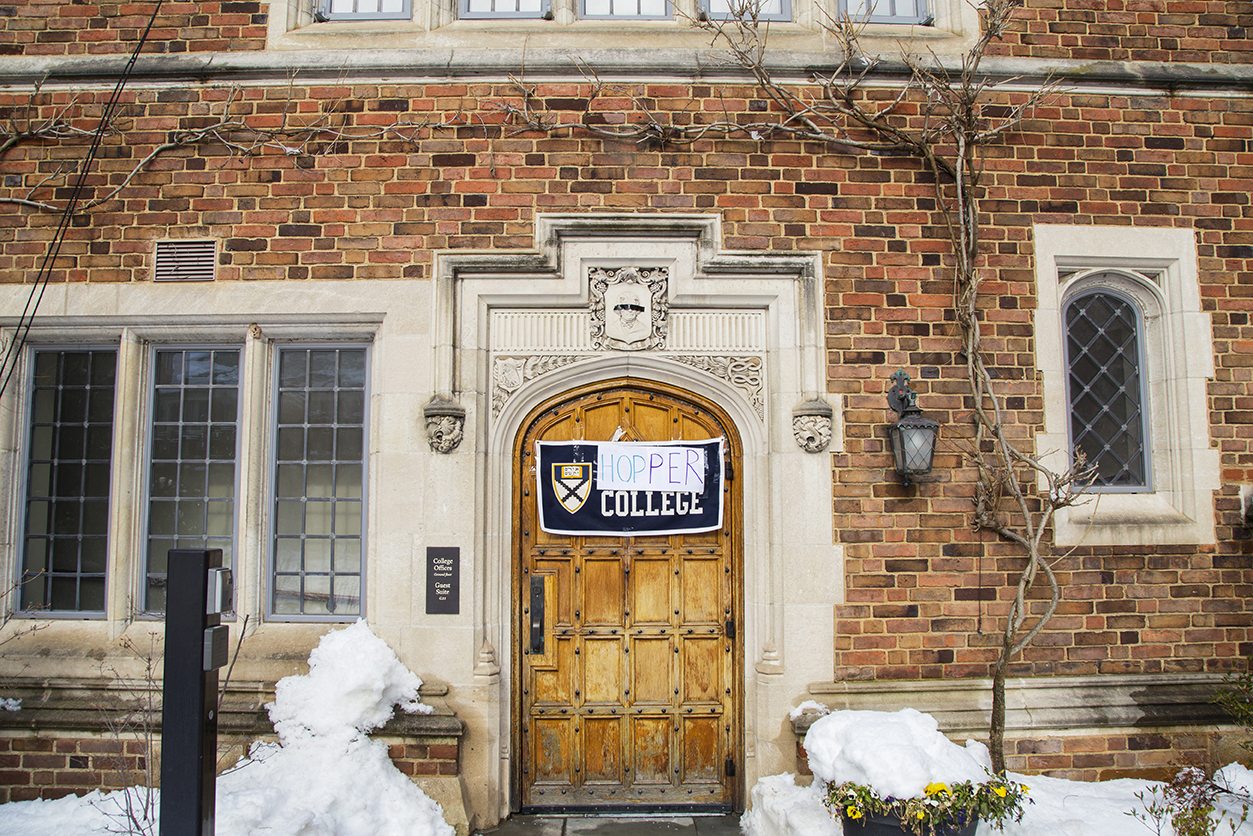
Throughout her career as a Navy admiral, Grace Hopper GRD ’34 kept a special kind of clock in her office: A clock that ran counterclockwise.
For Hopper, “the most damaging phrase in the language is ‘we’ve always done it that way,’” her nephew, Roger Murray, said in a speech in the Grace Hopper College dining hall on Tuesday afternoon.
Murray joined a crowd of more than 150 students, faculty members and administrators gathered in the dining hall for a dedication ceremony at the newly renamed Hopper College. The event capped decades of contentious debate over the naming of Calhoun College, which was rechristened in honor of Hopper this past July 1.
With the college’s newly designed coat of arms hanging on the wall behind him, University President Peter Salovey praised Hopper for her “trailblazing leadership” and dedication to her country.
“As a teacher, mentor and distinguished naval officer, she served others and her country with courage and dedication,” Salovey said in a speech. “Here, students will live, learn and challenge each other to live lives of meaning and purpose. One day, like Grace Hopper, they too will change the world.”
A computer pioneer and naval officer, Hopper earned a master’s degree and doctorate in mathematics from Yale in the 1930s. She went on to discover new ways to deploy computer code and developed programs that used word commands.
“She paved the way for the Navy in the digital revolution,” Admiral John Richardson, chief of Naval Operations, said in remarks at the ceremony. “Grace Hopper’s example will serve as an inspiration for generations of Yale students and faculty.”
In an interview with the News, Sam Cox, director of naval history for the U.S. Navy, called Hopper “a real trailblazer” for her pioneering work in computer science at a time when the Navy was dominated by men.
But Hopper was not only a leader in her field. She was a “character,” her nephew said, with a dry sense of humor and wide array of interests. As rear admiral, Hopper liked to carry her papers in a red wagon around the Pentagon and never travelled without a book in hand, Murray said. She read widely, he added, on such topics as New England’s architecture and history.
A parade of high-profile guests gathered at Hopper for the dedication, from Salovey and Yale College Dean Marvin Chun to Richardson and the celebrity news anchor Katie Couric.
But one figure was conspicuously absent from the program: statesman and slavery advocate John C. Calhoun, class of 1804, whose austere portrait once hung at the back of the dining hall.
At the end of the ceremony, Chun stepped to the podium to present Julia Adams, the head of Hopper, with a ceremonial mace cane — a traditional feature of the residential college graduation ceremony each spring — bearing the college’s new blue-and-white crest. The college’s original cane had belonged to Calhoun.
The ceremony marked the end of a two-year-long debate over the name of Calhoun College. The discussion began in earnest in the summer of 2015 after the fatal shooting of nine black churchgoers in Charleston, South Carolina.
Following a year of debate at Yale, Salovey announced in April 2016 that the University would keep the Calhoun name to avoid “erasing history.”
But student and faculty backlash to that decision forced Salovey to reconsider. In August 2016, he charged the Committee to Establish Principles on Renaming with creating guidelines for all renaming decisions at Yale, starting with the fate of Calhoun College. Using the committee’s report, the Yale Corporation decided last February to rename the college in honor of Hopper.
For Hopper students, the dedication ceremony marked the closure of a period of division and the beginning of “a concrete sense of community,” said Sergio Infante ’18.
For months, the Hopper and Yale communities grappled with the college’s identity. After the original decision not to rename in April 2016, students held their own renaming ceremony and began referring to the college as “the college formerly known as Calhoun.”
“We had all these spirit events and traditions that were supposed to bring us into college life, but they were tinged with anger and resentment,” Sofia Laguarda ’20 said. “We had to qualify everything we did as a community: ‘We are a group but we disagree with the thing that brings us together.’”
In the wake of the name change, however, Laguarda said she has noticed a “new excitement and enthusiasm” among students in the college.
“We all learned a tremendous amount and the community bonded more as a result,” said Adams, shortly after receiving the cane. “It was … time for a fresh start, and we have it today.”
Hailey Fuchs | hailey.fuchs@yale.edu | @Hailey_Fuchs
David Yaffe-Bellany | david.yaffe-bellany@yale.edu | @yaffebellany








